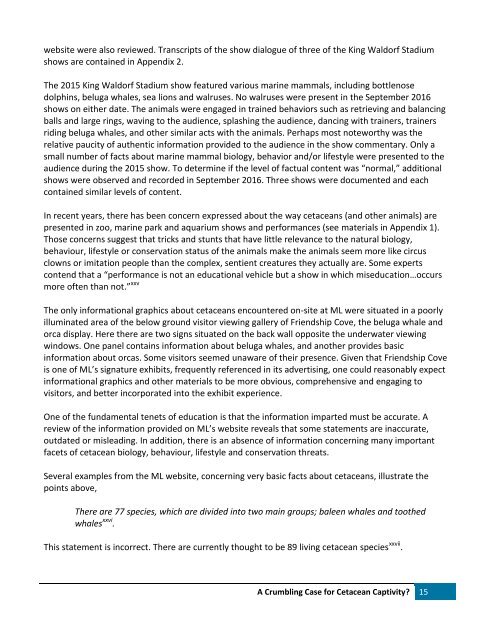A CRUMBLING CASE FOR CETACEAN CAPTIVITY?
MM-Education-and-Conservation-Report-Dec-9-2016-fi
MM-Education-and-Conservation-Report-Dec-9-2016-fi
You also want an ePaper? Increase the reach of your titles
YUMPU automatically turns print PDFs into web optimized ePapers that Google loves.
website were also reviewed. Transcripts of the show dialogue of three of the King Waldorf Stadium<br />
shows are contained in Appendix 2.<br />
The 2015 King Waldorf Stadium show featured various marine mammals, including bottlenose<br />
dolphins, beluga whales, sea lions and walruses. No walruses were present in the September 2016<br />
shows on either date. The animals were engaged in trained behaviors such as retrieving and balancing<br />
balls and large rings, waving to the audience, splashing the audience, dancing with trainers, trainers<br />
riding beluga whales, and other similar acts with the animals. Perhaps most noteworthy was the<br />
relative paucity of authentic information provided to the audience in the show commentary. Only a<br />
small number of facts about marine mammal biology, behavior and/or lifestyle were presented to the<br />
audience during the 2015 show. To determine if the level of factual content was “normal,” additional<br />
shows were observed and recorded in September 2016. Three shows were documented and each<br />
contained similar levels of content.<br />
In recent years, there has been concern expressed about the way cetaceans (and other animals) are<br />
presented in zoo, marine park and aquarium shows and performances (see materials in Appendix 1).<br />
Those concerns suggest that tricks and stunts that have little relevance to the natural biology,<br />
behaviour, lifestyle or conservation status of the animals make the animals seem more like circus<br />
clowns or imitation people than the complex, sentient creatures they actually are. Some experts<br />
contend that a “performance is not an educational vehicle but a show in which miseducation…occurs<br />
more often than not.” xxv<br />
The only informational graphics about cetaceans encountered on-site at ML were situated in a poorly<br />
illuminated area of the below ground visitor viewing gallery of Friendship Cove, the beluga whale and<br />
orca display. Here there are two signs situated on the back wall opposite the underwater viewing<br />
windows. One panel contains information about beluga whales, and another provides basic<br />
information about orcas. Some visitors seemed unaware of their presence. Given that Friendship Cove<br />
is one of ML’s signature exhibits, frequently referenced in its advertising, one could reasonably expect<br />
informational graphics and other materials to be more obvious, comprehensive and engaging to<br />
visitors, and better incorporated into the exhibit experience.<br />
One of the fundamental tenets of education is that the information imparted must be accurate. A<br />
review of the information provided on ML’s website reveals that some statements are inaccurate,<br />
outdated or misleading. In addition, there is an absence of information concerning many important<br />
facets of cetacean biology, behaviour, lifestyle and conservation threats.<br />
Several examples from the ML website, concerning very basic facts about cetaceans, illustrate the<br />
points above,<br />
There are 77 species, which are divided into two main groups; baleen whales and toothed<br />
whales xxvi .<br />
This statement is incorrect. There are currently thought to be 89 living cetacean species xxvii .<br />
A Crumbling Case for Cetacean Captivity? 15


